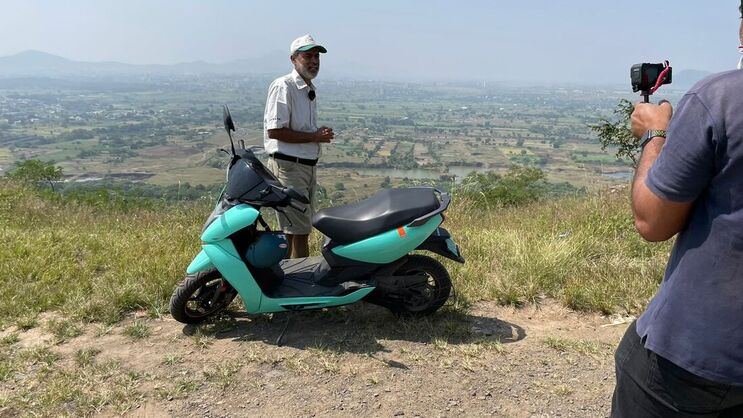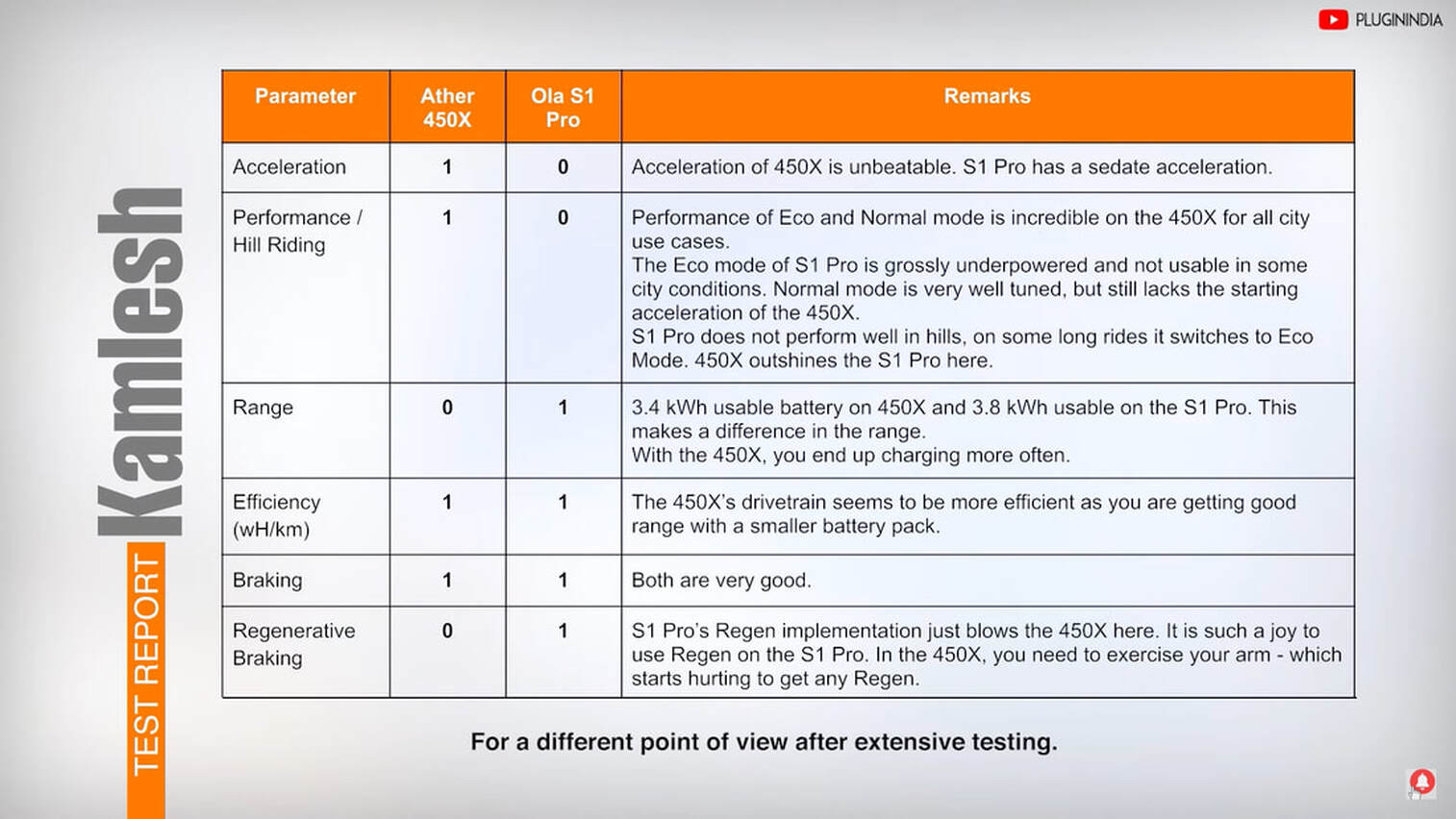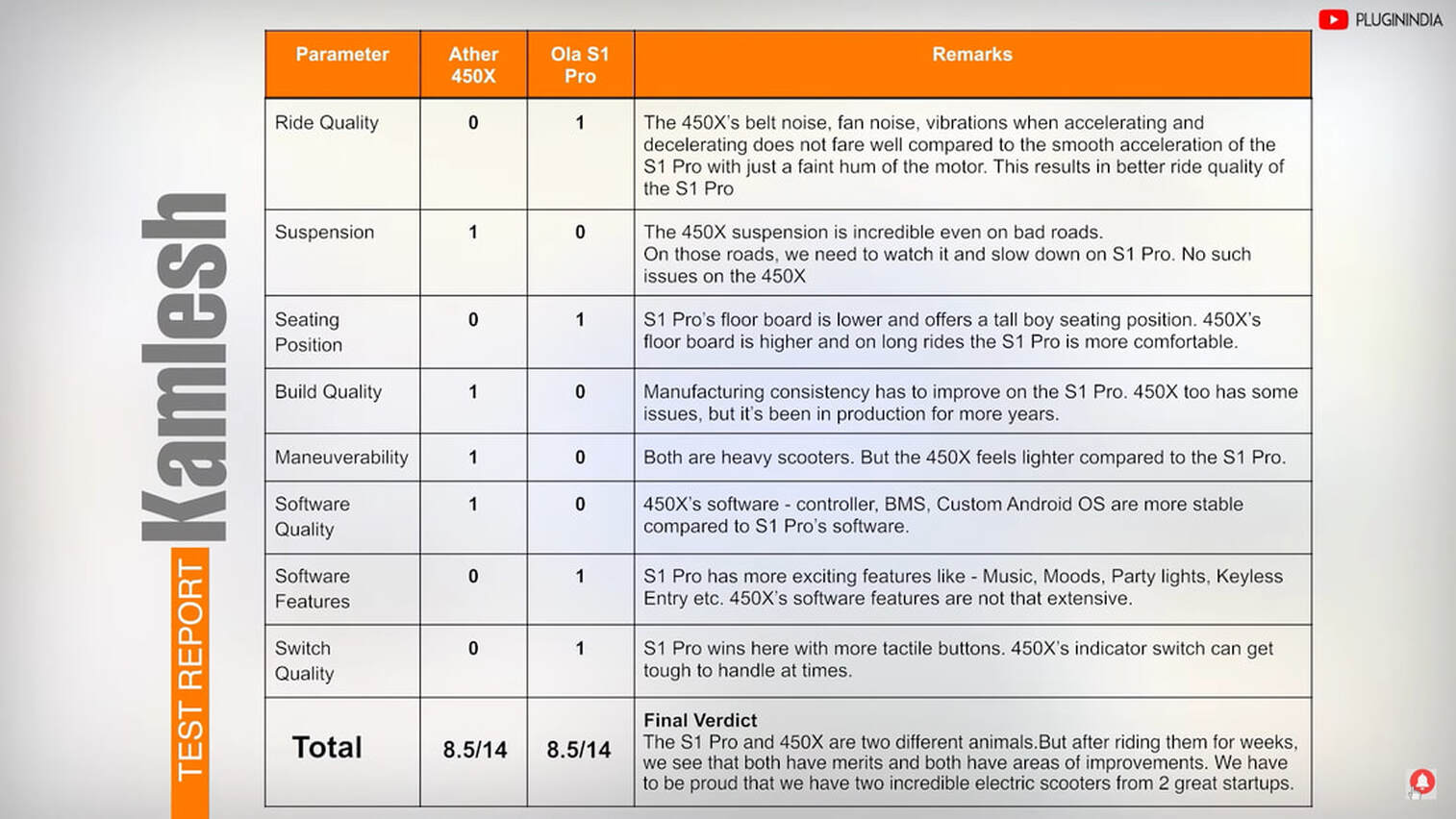By Atul & Kamlesh
We have had the OLA S1 Pro and the Ather 450X for more than a week. We did extensive riding and testing on both the models. Here are our findings and ratings!
We have had the OLA S1 Pro and the Ather 450X for more than a week. We did extensive riding and testing on both the models. Here are our findings and ratings!
Video: Ather 450X Gen3 vs OLA S1 pro : Comparison Test Report | हिन्दी with subtitles
Atul's Notes
We had done our first Ather test ride about 3 years ago. I quote from the review - The indigenous Mahle 5 kW motor delivers on the crazy acceleration figures. The 3 kW battery that it is married to it, makes for an Amitabh-Jaya story. The battery needs to raise its stature to meet the Big B motor standards. The Ather team has been listening, We received the new high range 450 X Gen 3 – where the battery has been upped 25% from 3 kWh to 3.7 kWh.
We rode the bike for 100 km in Eco mode over 2 days. The 450 X Gen 3 delivered on a 110 km range. Here is what the data says:
We note that the DTE algorithm learns from terrain and driver behavior – and keeps on tweaking the DTE to get more accurate as the ride progresses. We started with a DTE of 105 km – and it kept on creeping up to get to 111 km by the end of the ride. (We use sum of actual km run and DTE displayed to get to the end value.) Point to be noted was that most of the driving happened quite consistently in Eco mode. We did not go in for mix mode because we wanted to find out what is the maximum juice that can be extracted out of the pack. Mind you, Ather’s Eco mode is not like Ola’s. Top speed is 50 kmph – and acceleration is decent even in Eco mode.
The average wh per km reported was 27.4. So the energy math is that a 27.4 * 100 = 2.74 kWh energy was consumed. But when we look at data of battery SOC, we get figures that don’t match up. 87% of the battery was consumed for this distance, so kWh consumed is 3.7 * 0.87 = 3.22 kWh. So what is happening? Maybe 10% of battery is ‘locked out’ as reserve – to avoid deep discharge – and improve battery life. In which case, usable battery capacity would be 3.33 kWh. And if we have used 87% of that, it comes out to 2.89 kWh, which is close to the 2.74 kWh that we observed. Another hypothesis is that the energy drawn to power the DRL, keep the onboard devices running when the scooter is technically ‘switched off’ are not included in the wh per km math.
When Tarun and Swapnil started off at the incubation center at IIT Madras, their mentor asked them to spend 2 years in China to understand the EV ecosystem. And I believe that those two years have resulted in a design which will stand the test of time. The aluminium chassis was a brave decision – and it kind of reminds me of Jaguar, which has also been wedded to aluminium for many years. Aluminium helps get better power to weight ratios. Also the chassis dynamics is different about extruded or die-cast aluminium. You realise it when you are traversing rough roads. It has the right balance of stiffness and flexibility.You can go through pot holes and bad patches and the chassis absorbs all the shocks that you throw at it.
But then it does have its flip side too. For accident cases – the chassis repair costs are going to be high, because of the all aluminium body. Also cracks in battery case can be hazards. In May, there was a fire involving an Ather scooter. I quote from Ather’s official statement: The said scooter was water-washed, post which the crack in the battery case (likely caused as a result of the accident it was involved in) was discovered. And by that time, water had already seeped into the pack, which resulted in a short circuit, that was then followed by a thermal runaway event that caused the fire. But looking at the law of averages, I would still vouch for Ather being one of the safest scooters on the market. One swallow does not a summer make. Ather can see many more million vehicle km under its belt before the next fire. And it is something that the EV community has to learn to accept. Even petrol vehicles are prone to fires, even after a hundred years of engineering.
We had done our first Ather test ride about 3 years ago. I quote from the review - The indigenous Mahle 5 kW motor delivers on the crazy acceleration figures. The 3 kW battery that it is married to it, makes for an Amitabh-Jaya story. The battery needs to raise its stature to meet the Big B motor standards. The Ather team has been listening, We received the new high range 450 X Gen 3 – where the battery has been upped 25% from 3 kWh to 3.7 kWh.
We rode the bike for 100 km in Eco mode over 2 days. The 450 X Gen 3 delivered on a 110 km range. Here is what the data says:
- SOC (%) Distance (km) DTE (km)
- 100 0 105
- 80 26.3 82
- 60 48.6 59
- 38 72.4 36
- 19 92.8 17
- 13 99.8 11
We note that the DTE algorithm learns from terrain and driver behavior – and keeps on tweaking the DTE to get more accurate as the ride progresses. We started with a DTE of 105 km – and it kept on creeping up to get to 111 km by the end of the ride. (We use sum of actual km run and DTE displayed to get to the end value.) Point to be noted was that most of the driving happened quite consistently in Eco mode. We did not go in for mix mode because we wanted to find out what is the maximum juice that can be extracted out of the pack. Mind you, Ather’s Eco mode is not like Ola’s. Top speed is 50 kmph – and acceleration is decent even in Eco mode.
The average wh per km reported was 27.4. So the energy math is that a 27.4 * 100 = 2.74 kWh energy was consumed. But when we look at data of battery SOC, we get figures that don’t match up. 87% of the battery was consumed for this distance, so kWh consumed is 3.7 * 0.87 = 3.22 kWh. So what is happening? Maybe 10% of battery is ‘locked out’ as reserve – to avoid deep discharge – and improve battery life. In which case, usable battery capacity would be 3.33 kWh. And if we have used 87% of that, it comes out to 2.89 kWh, which is close to the 2.74 kWh that we observed. Another hypothesis is that the energy drawn to power the DRL, keep the onboard devices running when the scooter is technically ‘switched off’ are not included in the wh per km math.
When Tarun and Swapnil started off at the incubation center at IIT Madras, their mentor asked them to spend 2 years in China to understand the EV ecosystem. And I believe that those two years have resulted in a design which will stand the test of time. The aluminium chassis was a brave decision – and it kind of reminds me of Jaguar, which has also been wedded to aluminium for many years. Aluminium helps get better power to weight ratios. Also the chassis dynamics is different about extruded or die-cast aluminium. You realise it when you are traversing rough roads. It has the right balance of stiffness and flexibility.You can go through pot holes and bad patches and the chassis absorbs all the shocks that you throw at it.
But then it does have its flip side too. For accident cases – the chassis repair costs are going to be high, because of the all aluminium body. Also cracks in battery case can be hazards. In May, there was a fire involving an Ather scooter. I quote from Ather’s official statement: The said scooter was water-washed, post which the crack in the battery case (likely caused as a result of the accident it was involved in) was discovered. And by that time, water had already seeped into the pack, which resulted in a short circuit, that was then followed by a thermal runaway event that caused the fire. But looking at the law of averages, I would still vouch for Ather being one of the safest scooters on the market. One swallow does not a summer make. Ather can see many more million vehicle km under its belt before the next fire. And it is something that the EV community has to learn to accept. Even petrol vehicles are prone to fires, even after a hundred years of engineering.
The Gen 3 also has a few more tweaks. The already good suspension gets better with the new tread MRF tyres, which have better grip on wet roads. Usually more grip means lower wh per km. But I guess with the larger battery, Ather could afford to let go of a few wh per km. Having said that in my last trip I had got 29 wh/km, which was 2 more than the 27 wh/km that I got this time.
The other development on the tyre front has been a new TPMS (Tyre pressure monitoring system). Most sensors are fitted on the valve – and send info to the user via blue tooth. This makes them prone to theft. Ather’s new TPMS fits on the rim, and so is less likely to be flicked. It would be a good idea for the TPMS to send reminders on the vehicle screen to fill up. Drop in pressure can lead to a 2 to 5% increase in wh per km – and the concomitant drop in range. But I still feel the better idea is to just have the discipline to check tyre pressure every two weeks. The TPMS, which costs Rs. 5,000 comes with a non-replaceable battery. So you are creating a piece of junk every 3-5 years, which I don’t think is a good idea. If you are already an Ather owner, you would be better off spending the same money on a set of the new tread tyres.
And there are a few tweaks more. Finally, Ather gets a Rs 2200 ladies foot rest. But it cannot be retrofitted onto older vehicles. The dash is more responsive, thanks to an increase in onboard memory. The rear view mirrors are now easier to adjust. The home charger should be the default option on new vehicles. The build quality is good. And it a good charger costs Rs. 10 K+. For the time being, Ather is selling it at half the price. The on road price of the vehicle in Pune, including the portable charger, is Rs. 1,46,340 plus insurance plus road tax. It comes with a warranty of 3 years. Interestingly, the battery warranty is 3 years, unlimited km. Reminds me of the unlimited thali. I guess there will be very few riders who will be doing a 100 km a day – and getting to 100,000 km in 3 years. So Ather does not need to worry so much about km. But it is reassuring in the same way that if you do end up getting hungry, more food can be served in the unlimited thali.
So what change would I still want to see in the gaddi? Belt noise and vibration are still irritants. Reminds me of the times when Harley Davidson bikes would leak lube oil – and the Harley fans would justify it by saying that if it ain’t leaking it ain’t a Harley. So would the die hard Ather fans want the noise, in spite of the objections of the quieter roads community of India? I think that noise is a sign of something wrong in the system. And the vehicle I received had a very jarring vibration at low speeds that accompanied this noise. It kind of takes away the zen from this otherwise marvellous vehicle. Will let Tarun bhai meditate on this issue.
The other development on the tyre front has been a new TPMS (Tyre pressure monitoring system). Most sensors are fitted on the valve – and send info to the user via blue tooth. This makes them prone to theft. Ather’s new TPMS fits on the rim, and so is less likely to be flicked. It would be a good idea for the TPMS to send reminders on the vehicle screen to fill up. Drop in pressure can lead to a 2 to 5% increase in wh per km – and the concomitant drop in range. But I still feel the better idea is to just have the discipline to check tyre pressure every two weeks. The TPMS, which costs Rs. 5,000 comes with a non-replaceable battery. So you are creating a piece of junk every 3-5 years, which I don’t think is a good idea. If you are already an Ather owner, you would be better off spending the same money on a set of the new tread tyres.
And there are a few tweaks more. Finally, Ather gets a Rs 2200 ladies foot rest. But it cannot be retrofitted onto older vehicles. The dash is more responsive, thanks to an increase in onboard memory. The rear view mirrors are now easier to adjust. The home charger should be the default option on new vehicles. The build quality is good. And it a good charger costs Rs. 10 K+. For the time being, Ather is selling it at half the price. The on road price of the vehicle in Pune, including the portable charger, is Rs. 1,46,340 plus insurance plus road tax. It comes with a warranty of 3 years. Interestingly, the battery warranty is 3 years, unlimited km. Reminds me of the unlimited thali. I guess there will be very few riders who will be doing a 100 km a day – and getting to 100,000 km in 3 years. So Ather does not need to worry so much about km. But it is reassuring in the same way that if you do end up getting hungry, more food can be served in the unlimited thali.
So what change would I still want to see in the gaddi? Belt noise and vibration are still irritants. Reminds me of the times when Harley Davidson bikes would leak lube oil – and the Harley fans would justify it by saying that if it ain’t leaking it ain’t a Harley. So would the die hard Ather fans want the noise, in spite of the objections of the quieter roads community of India? I think that noise is a sign of something wrong in the system. And the vehicle I received had a very jarring vibration at low speeds that accompanied this noise. It kind of takes away the zen from this otherwise marvellous vehicle. Will let Tarun bhai meditate on this issue.
Kamlesh Notes
I own the OLA S1 Pro, but i enjoyed testing the Ather immensely.
Finally, ahem!
I own the OLA S1 Pro, but i enjoyed testing the Ather immensely.
- I'm so used to key less entry on Ola that I park the Ather and start walking. Then I remember I need to take the key ? out!
- I love this Trip A and efficiency(Wh/km) data of Ather. We still don't have this on the OLA.
- Ather Eco mode acceleration is amazing! The Ola eco mode is a joke. I call it the PR mode. ?
- The Ather long time to charge upto 100%. Looks like the rate of charging slows down dramatically as SOC goes higher. That seems to be a conservative design, which i appreciate.
- Not happy with the Ather's ride quality. Vibrations, there is a certain roughness of ride. You also listen to the fan noise. All of this can get annoying after a while on longish rides. The moment u step on it Ola. U feel the quality of ride difference. It's Smooth!
- Suspension on the Ather is incredible. Any road is not an issue. It beats the OLA here!
- I love “One Pedal” driving in an electric car and i always wished electric scooters should also have this feature of aggressive regenerative braking, where we don't have to to use the brakes in most situation's.
Regen braking is possible on the Ather. Although the implementation sucks, due to the effort needed for reverse twist of the throttle. Also when when you let go of the throttle, there is no regen on the Ather. On the OLA, when you let go of the throttle, you can sense the motor becoming a generator and you can feel there is slight resistance while the scooter slows down.
The fact that I can ride the OLA S1 Pro in “One Pedal” mode is exciting! In many of my rides in bumper to bumper city traffic, I never even once touched the brakes for more than 5 km! Use the motor to slow down. By getting rid of the constant pattern of applying brakes and accelerating, the takes way a lot of stress for you as a rider and also protects the brake pads. It truly is a zen way of riding with the magic of Regen on the OLA. - I love the sound the Ather makes! So futuristic! So Electric! Many people don't like it, but i love it!
- I appreciate how open Ather are when it comes to talking about EV Tech. I don't like how OLA are very closed about tech talks. I asked the Ather dev about BMS improvements and features and here is the reply.
- The BMS monitors currents, temperatures, and voltages to determine optimal charge and discharge values for the battery to avoid any interruptions or degradations in the user riding and charging experience while ensuring safety.
- The BMS significantly increases standby time (which means it takes a longer time for it to drain while not in use)
- Protection when charging and discharging
- Over and under voltage protection
- Overcurrent protection
- Over and under temperature protection
- Reading and computing state-of-charge and state-of-health
- Voltage monitoring of individual cells
- Cell temperature and current measurement
- Balancing
- De-rating
- More notes on each parameter's are below.
Finally, ahem!
- Riding the Ola is like experiencing an Orchestra ?
- Riding the Ather is like rocking to heavy metal ?










